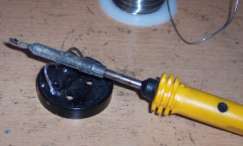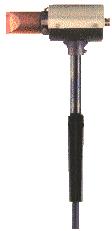Categories: Sharing experience, Novice electricians
Number of views: 64465
Comments on the article: 1
Soldering: very simple tips
Soldering, fluxes, solders and how to work with a soldering iron? What soldering iron to use, what are the fluxes and solders? And, a little about what a soldering station is ...
Tinker - a person engaged in soldering metal products.
From a very old reference ...
About soldering, soldering equipment, fluxes and solders
 Not a single serious repair is complete without soldering work. There is a soldering iron in almost every house, and soldering now the usual thing is not only techies of specialists, but also any amateur amateur craftsman. Without high-quality soldering, the normal operation of an electronic device (at least a contact on a chandelier, at least a capacitor on a motherboard) sooner or later, with a high probability, will be disrupted. Since during soldering, the solder and the part of the metal to which it is applied are mutually dissolved, after cooling, a rather strong joint is obtained that has good electrical conductivity. But in order for the connection to turn out to be really high-quality and durable, you have to take into account some nuances
Not a single serious repair is complete without soldering work. There is a soldering iron in almost every house, and soldering now the usual thing is not only techies of specialists, but also any amateur amateur craftsman. Without high-quality soldering, the normal operation of an electronic device (at least a contact on a chandelier, at least a capacitor on a motherboard) sooner or later, with a high probability, will be disrupted. Since during soldering, the solder and the part of the metal to which it is applied are mutually dissolved, after cooling, a rather strong joint is obtained that has good electrical conductivity. But in order for the connection to turn out to be really high-quality and durable, you have to take into account some nuances
Soldering irons, soldering stations
 The main difference between soldering irons is power. For repair of printed circuit boards and the installation of small elements sensitive to static voltage, soldering irons with a power of 24-40 watts are used. For soldering wide conductors, power buses and various massive elements - 40-80 watts. Soldering irons of 100 watts or more are mainly used for soldering massive steel structures, especially non-ferrous metals with high thermal conductivity.
The main difference between soldering irons is power. For repair of printed circuit boards and the installation of small elements sensitive to static voltage, soldering irons with a power of 24-40 watts are used. For soldering wide conductors, power buses and various massive elements - 40-80 watts. Soldering irons of 100 watts or more are mainly used for soldering massive steel structures, especially non-ferrous metals with high thermal conductivity.
Do not forget about the supply voltage. The standard in Russia is 220V, 50Hz, but for soldering, for example in a car or in other places where it is difficult to find a socket, you can use soldering irons with a voltage of 12/18 / 24V. Another important characteristic of a soldering iron is its operating temperature. The simplest samples do not have a clear temperature regime, and with insufficient heating of the soldering place, when the solder does not melt to a state of fluidity and cannot fill all the gaps intended for it, a rather frequent effect called “cold soldering” is observed. The junction is matte, rough and the connection is fragile.
An overheated soldering iron tip accelerates its wear, while the solder overheats, the tip is scaled, the flux burns out, the adhesion of the solder to the tip worsens. Often, the soldering iron tip overheats due to excessive evaporation of the solder, as a result of the field elements and microcircuits overheat, the tracks of the printed circuit boards peel off. It is naturally impossible to produce high-quality work with a soldering iron with a low or too high temperature.
In case soldering is a frequent affair for you, you will have to get a set of soldering irons of various capacities, and even better soldering station, since they have temperature controllers, automatic maintenance of the set temperature, a convenient stand for a soldering iron, a bath for a cleaning sponge, antistatic protection and some additional features. A good soldering station, of course, is not cheap, but a set of different soldering irons and high-quality nozzles for them can cost no less ...
Solders and fluxes
Flux, which is usually used spruce or pine rosin, is necessary to dissolve and remove oxides, as well as protect the solder from oxidation. Many people use an alcohol solution of rosin, applying it with a brush to the place of soldering. It is not difficult to make such a solution yourself, but instead of alcohol, you can use another solvent, for example gasoline or acetone. The main disadvantage of rosin is that at excessively high temperatures, not only the oxide film is removed from the metal, the metal itself is also removed.
 Solder, an alloy of tin with lead, is needed to connect soldered parts. Solders are divided into refractory (hard solders) and low-melting (soft solders). Available in the form of grains, sticks, rods, strips, ribbons, wire, rosin-filled tubes, powders and pastes with liquid flux. For home repairs, including computer equipment, fusible solders with a relatively low melting point up to 300 ° C are used, for example, POS-61. The designation PIC stands for - tin-lead solder, the figure at the end is the percentage of tin. To obtain special properties, cadmium (POSK), bismuth (POSV), antimony (POSS) and other metals are added to tin-lead solders.
Solder, an alloy of tin with lead, is needed to connect soldered parts. Solders are divided into refractory (hard solders) and low-melting (soft solders). Available in the form of grains, sticks, rods, strips, ribbons, wire, rosin-filled tubes, powders and pastes with liquid flux. For home repairs, including computer equipment, fusible solders with a relatively low melting point up to 300 ° C are used, for example, POS-61. The designation PIC stands for - tin-lead solder, the figure at the end is the percentage of tin. To obtain special properties, cadmium (POSK), bismuth (POSV), antimony (POSS) and other metals are added to tin-lead solders.
The most convenient is the use of tubes with a diameter of 2-3 mm with a rosin channel inside. Can solder as usual, grabbing a drop of tin from the tube and transferring it to the place of soldering or pressing the tip of the soldering iron to the place of soldering, bring the tip of the tube to it. At the same time, the tube melts, flowing into the gaps, moreover, due to its small diameter, the amount of solder is easily dosed.
Soldering tips
Choose a soldering iron with the ability to change the tips, which now offer a whole range. These are the blades, cones, needles, in general it all depends on the specific needs and your financial capabilities.
Allow a cleaning sting a couple of minutes before any work, if the dirt is too strong, use a file. It is convenient to use a piece of wood or cardboard to remove the remains of burnt flux, dust and oxide from the sting (although many do this with a quick movement of the fingers, which is also effective in principle).
When using a conventional soldering iron for protection against static, it is advisable to connect the antistatic wrist strap worn on the hand with the soldering iron and the body of the device being repaired.
When warming up the soldering iron, do not leave it “dry”, be sure to immerse the soldering iron tip in the rosin as soon as it warms up to a temperature that can melt it. A layer of rosin on the surface of the sting will protect it from oxidation. When heated to the melting point of the solder, it must be tinned.
 It is undesirable to use metal boxes, lids, and cans to store the solder, since the solder that adheres to their surface sticks, the metal of such a box (especially if it is also used as a soldering iron stand) heats up, difficulties arise with accurate dosing, and as a result a tin-rosin porridge is formed, with which it will not be very convenient to work.
It is undesirable to use metal boxes, lids, and cans to store the solder, since the solder that adheres to their surface sticks, the metal of such a box (especially if it is also used as a soldering iron stand) heats up, difficulties arise with accurate dosing, and as a result a tin-rosin porridge is formed, with which it will not be very convenient to work.
A prerequisite for the formation of a reliable soldered contact is equal temperatures of the soldered surfaces.
Clean in advance, degrease with gasoline or other organic solvent and tin the pads before soldering. A common mistake is that some components are first soldered, and then they bite off the extra length of the legs and try to remove excess drops of solder.
Do not forget about the extreme temperatures of electronic components, especially field effect transistors and integrated circuits. At a temperature of 260-300C do not exceed the soldering time by more than 5-10 seconds.
By changing the length of the soldering iron tip - you can change the temperature. But it is much more convenient to do this using an autotransformer or a special regulatory device. Of course, this does not apply to the happy owners of the soldering station.
Theoretically, the temperature of the soldering iron tip should correspond to the solder used and the total heat removal of the soldered parts. Of course, this is not easy to calculate, but upon gaining experience, it is guessed “by eye”. Harmonious, accurate and high-quality soldering comes with time and experience. Do not be afraid of a soldering iron, practice, count on your common sense and intuition! After all, a soldering iron is the main tool for any more or less serious repair!
See also at bgv.electricianexp.com
:
